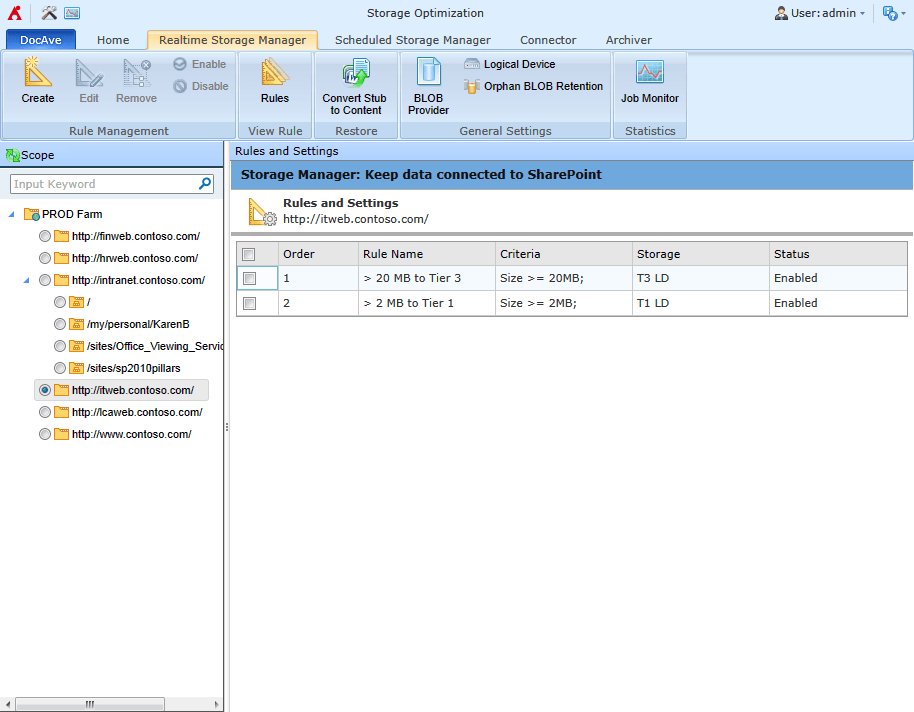Many organizations want to meet seemingly contradictory goals: they are looking to integrate SharePoint even more deeply into their business process and collaboration while, at the time, searching desperately for ways to mitigate the significant top-tier storage burden that SharePoint often creates. Files uploaded to SharePoint libraries and attachments to SharePoint list items (affectionately known as BLOBs, which stands for Binary Large Objects) can account for up to 90% of the content stored in SharePoint’s content databases.
A new product in DocAve 6, Storage Manager, delivers a comprehensive solution for storing BLOB content outside content databases, freeing up expensive SQL storage space, while maintaining transparent access to that content through SharePoint. Rather than being stored in SQL, the BLOB content can be stored on other types of storage like network shares, cloud storage, enterprise storage from IBM, Dell, EMC , and others. To gain insight on why this is an excellent idea and learn best practices, check out this white paper from our SharePoint Evangelists Dan Holme, Randy Williams, and Jeremy Thake.
Storage Manager is a flexible tool that allows you to manage BLOB content as it moves through the content lifecycle. BLOBs can be routed to appropriate storage locations on upload with Storage Manager’s “Realtime” rules, then moved to cheaper, more appropriate storage locations as they age and are accessed less often with Storage Manager’s “Scheduled” rules. Let’s look at an example. “Realtime” Storage Manager rules are based upon file size. Storage Manager offers the ability to have multiple real-time rules for ultimate flexibility on how to route BLOB content to storage. For example: - Rule 1: If > 20MB, send to storage device x with moderate compression o Slightly cheaper storage, compression maximizes our storage resources for big files - Rule 2: If > 2MB but < 20MB, send to storage device y o Best performance, small files so no need to compress
As time goes on, this content may be accessed less frequently. We may want to retain access to versions that begin to accumulate, but we don’t want to continue to store this BLOB content in the storage location where we originally placed it. This is where “Scheduled” Storage Manager rules will come in handy. Rules can be configured to examine content based on any business rule – document properties such as columns, metadata, version information, attachment information, and attachment properties as well as based upon filter conditions – and move matching BLOBs to the storage location of our choice, again retaining transparent access to the content from SharePoint. Again, let’s look at an example: - Rule : If BLOB has not been modified in six months OR - If it is a BLOB that is a version higher than 5
move BLOB to storage device z with high compression o Maximize the cost savings and storage resources by stored, rarely accessed content on our cheapest storage

With the combination of “Realtime” and “Scheduled” rules, DocAve Storage Manager really does give us the best of both worlds. And DocAve’s interface makes it easy to see all of the storage optimization rules configured for a defined location in SharePoint:

Now – what about when it’s time to retire this content and remove it from SharePoint? What if you want to retain the content for historical or compliance reasons? That’s where DocAve’s Archiver will come in handy – but that’s another post for another time. Bottom line: your business has dynamic, evolving requirements for its document storage, and your SharePoint deployment should be able to scale to those needs in order to lower total cost of ownership, improve end-user adoption, and limit business disruption. For more information on Storage Manager and DocAve 6, visit: https://www.avepoint.com/docave6.

